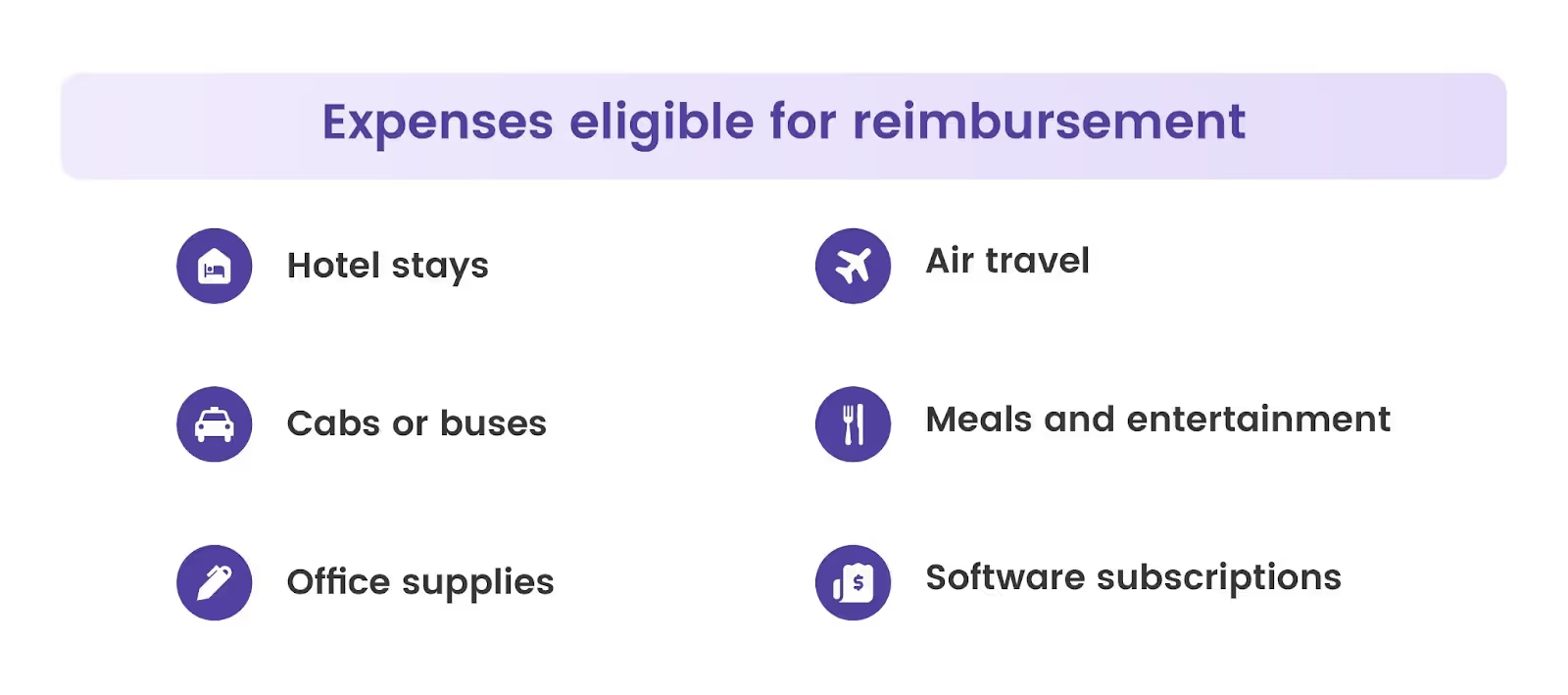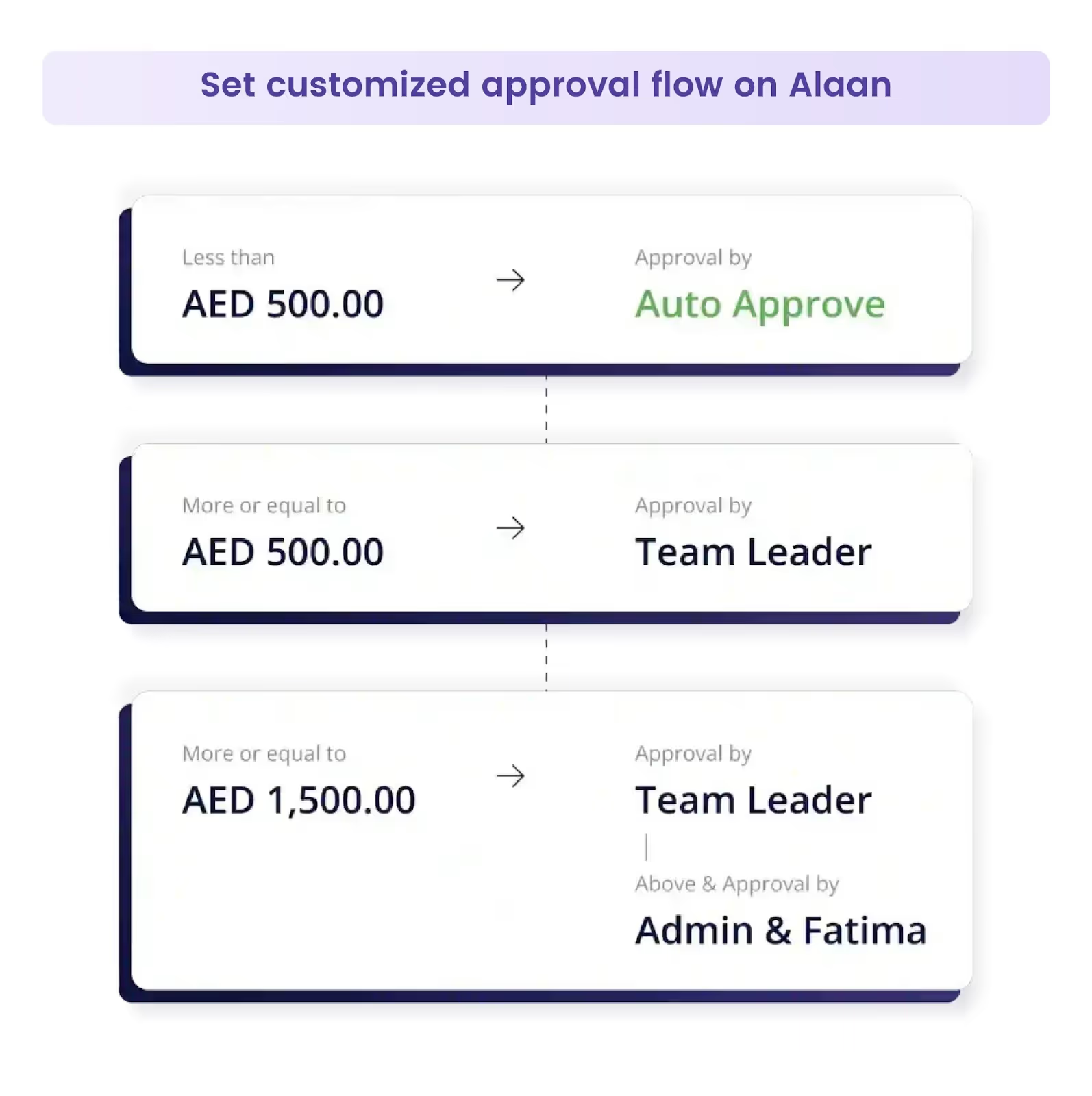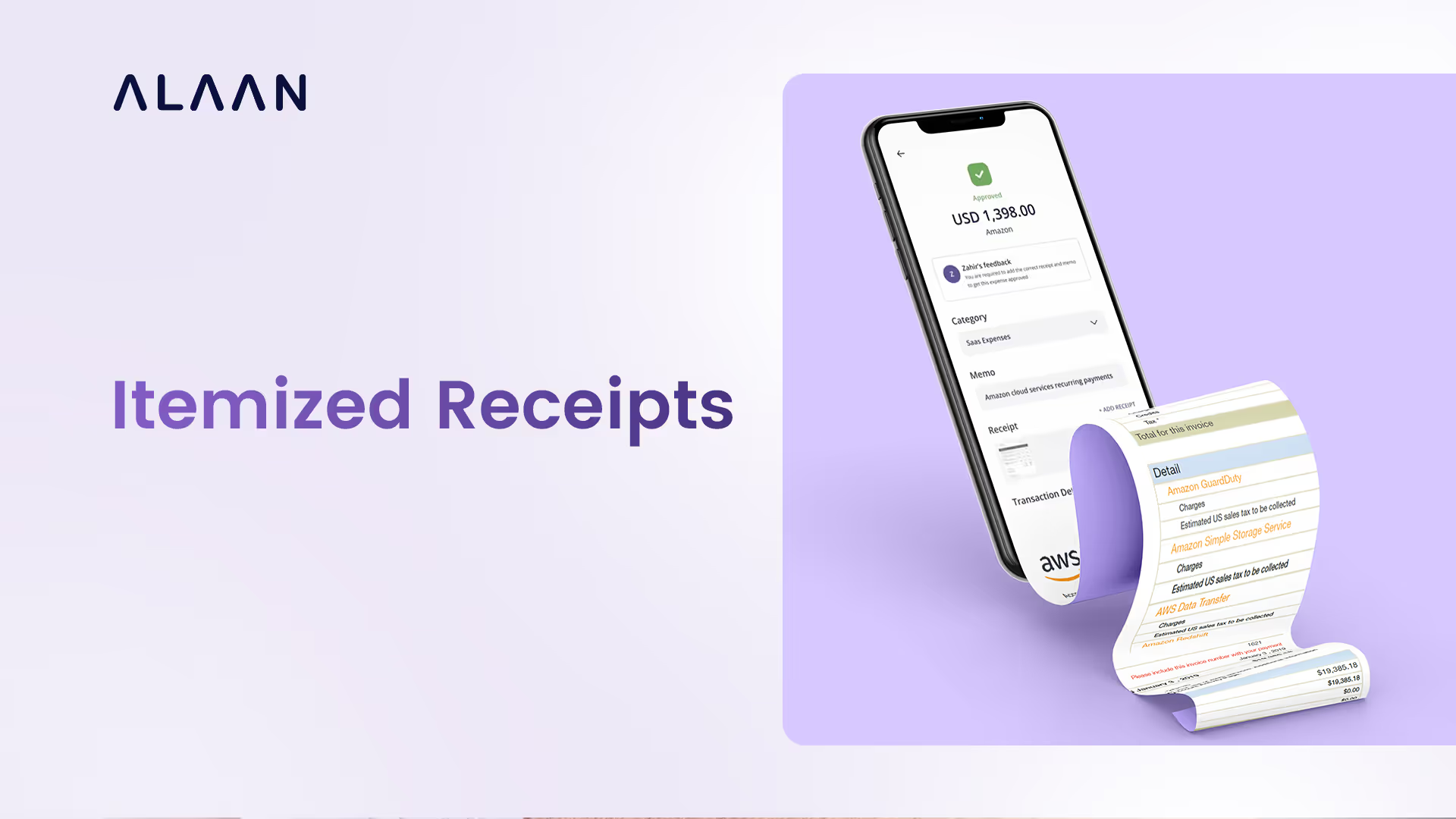As finance professionals, keeping track of employee spending can be a significant challenge. Employees often misplace or forget to submit expense receipts, and the manual process of sorting and verifying these documents can be time-consuming. These issues can directly impact your expense reporting process, leading to inefficiencies and additional costs.
On average, processing a single expense report for a one-night hotel stay costs $58 and takes 20 minutes. However, 19% of these reports has mistakes or missing information, resulting in an additional $52 and 18 minutes for corrections.
Understanding itemized receipts and how to automate the process can address these concerns and simplify your recordkeeping. In this blog, we will explore the key aspects of itemized receipts, why they are crucial, and how to streamline your expense management processes.

H2: What are itemized receipts?
An itemized receipt is a detailed document that provides a breakdown of each product or service purchased in a transaction. Unlike a regular receipt, which only shows the total amount paid, an itemized receipt lists each item or service separately, along with its particular cost. This means that instead of seeing a single total amount, you get to see a list of individual items, each with its price.
For example, if you purchase office supplies, a regular receipt might simply show the total amount spent. However, an itemized receipt would list each item you bought, such as pens, paper, staplers, etc., along with the quantity and price of each item. Such detailed information can be extremely useful for your business when it comes to financial management and expense tracking.
H3: What are the key components of an itemized receipt?
What exactly makes up an itemized receipt? Let’s break it down:
- Date of purchase: This is the date when the transaction took place. It is crucial for keeping track of expenses and for financial reporting.
- Vendor details: This includes the vendor's or service provider's name, address, phone number, and email ID. It is important to verify the transaction's authenticity.
- List of items or services purchased: This is where an itemized receipt really shines. Instead of just showing a total amount, it lists out each item or service purchased, providing a clear picture of where your money is going.
- Individual prices: Each item or service on the receipt is listed with its price. This level of detail can be beneficial for budgeting and cost analysis.
- Total amount: The total cost of all items or services purchased. It includes the sum of individual prices, along with any taxes or fees.
- Taxes: Any applicable taxes are listed separately on an itemized receipt. This can be helpful for tax compliance and reporting.
- Payment method: The receipt shows how the transaction was paid for, whether it was cash, credit card, or another method. This can be useful for tracking spending habits and for auditing purposes.
H2: Why do companies need itemized receipts?
By incorporating itemized receipts into your financial processes, you can enhance the overall efficiency and integrity of your operations. Here are the key reasons why itemized receipts are indispensable for companies.
H3: Accurate expense tracking
With each item or service purchased listed separately, along with its price, itemized receipts provide a detailed record of spending. It allows you to keep precise records of your spending, making it easier to identify spending patterns and areas where costs can be cut. For instance, if you notice that a considerable part of your budget is being spent on a particular item or service, consider looking for cost-effective alternatives.
H3: Fraud prevention
Itemized receipts provide a clear and detailed account of each purchase, making it harder for employees to inflate or fabricate expenses. This transparency can help create a culture of honesty and accountability within your company. A detailed receipt acts as proof of payment, allowing you to easily verify the authenticity of each transaction, reducing the risk of fraudulent expense claims.
H3: Tax compliance
itemized receipts also play a crucial role in tax compliance. They provide the necessary documentation to support tax deductions and ensure that all expenses are legitimate and properly accounted for. This can be particularly important in the UAE, where businesses need to comply with different tax regulations from the FTA (Federal Tax Authority). With itemized receipts, you can ensure that your business is always ready for tax time, reducing the risk of penalties or fines.
H3: Budget management
Itemized receipts offer a detailed view of expenditures and allow companies to allocate resources effectively and monitor adherence to budgets. This can help achieve better financial planning and control over business expenses. For instance, if you notice that your spending is consistently exceeding your budget in a particular area, consider implementing stricter budget controls.
H2: What are the common types of itemized expenses for employees?
In the course of business operations, employees often incur various expenses. These can range from business travel and accommodation to meals and office supplies. Let’s take a closer look at some of the typical categories of expenses that often need to be itemized:
- Hotel stays: When employees go on a business trip, they often need to stay in hotels. An itemized receipt for hotel stays should include the nightly rates, taxes, and any additional charges such as room service, parking fees, or internet access. This detailed breakdown can help you accurately track travel expenses and ensure that all costs are accounted for.
- Air travel: This is another common expense category for businesses. It is important to itemize airfare, baggage fees, in-flight purchases, and any additional charges. Itemizing these expenses ensures compliance with travel policies and provides a clear record of spending.
- Cabs or buses: Transportation is a necessary expense for many businesses. Whether employees are taking a cab to a meeting or using public transportation for business purposes, it is essential to itemize fares, tips, and any additional charges.
- Meals and entertainment: Business meetings often involve meals or entertainment. An itemized receipt for these expenses should include individual food and drink costs, as well as tips. This level of detail can help accurately track these expenses and ensure that they meet your company’s budget guidelines.
- Office supplies: Companies often need to purchase office supplies, such as stationery, electronics, or other office essentials. An itemized receipt for these purchases should list the individual costs of each item.
- Software subscriptions: In today’s digital age, many businesses rely on various software tools. An itemized receipt for software subscriptions should include the software name and version, validity (or subscription period), and contact details of the software provider. This can help streamline your software expenses and ensure that all subscriptions are up-to-date.

H2: Itemized receipts vs. Regular receipts
When managing business expenses, the type of receipt you use can make a significant difference. Let’s explore the key differences between itemized receipts and regular receipts:
H3: Transaction details
- Itemized receipts: The level of detail is one of the most noticeable differences between itemized and regular receipts. An itemized receipt lists individual items, including their quantities and prices. This provides a detailed breakdown of each transaction, making it easier to see exactly where your money is going.
- Regular receipts: On the other hand, regular receipts often provide a single total amount without any breakdown of the individual items or services purchased.
H3: Use cases
- Itemized receipts: These receipts are essential for detailed expense tracking and compliance. They provide an itemized list of each transaction, making it easier to manage your finances and ensure their proper accounting.
- Regular receipts: These receipts, while simpler, are typically used for proof of purchase without detailed breakdowns. They may be sufficient for personal use or small businesses with less complex financial needs.
H3: Accuracy
- Itemized receipts: These receipts provide clearer and more accurate records, reducing the risk of errors in expense reporting. By listing each item separately, they make it easier to spot any discrepancies or potential issues.
- Regular receipts: These receipts, lacking detailed breakdowns, can lead to misinterpretations and inaccuracies. For businesses, this could mean the difference between accurate financial reporting and costly mistakes.
H3: Compliance
- Itemized receipts: These receipts are compliant with tax and corporate policies because they provide a detailed account of purchases. They offer the necessary documentation to support tax deductions and ensure that all expenses are legitimate and properly accounted for.
- Regular receipts: These receipts, on the other hand, may not meet the requirements for detailed documentation needed for audits and tax deductions.

H2: How to automate itemized receipts?
Whether it be small companies or large corporations, businesses are always seeking methods to streamline their financial efficiency. One area where automation is especially important is in the handling of itemized receipts. Here are some methods and tools that can help you optimize this process:
- Opt for digital receipts: One of the simplest ways to automate the handling of itemized receipts is to encourage employees to submit digital receipts. Unlike paper receipts, digital receipts are easier to store, organize, and retrieve. They can be easily searched and sorted, reducing the risk of loss or damage. Digital receipts can be easily shared and accessed from anywhere, making them a convenient option for businesses.
- Use a receipt scanning app: Another effective method is to use a receipt scanning app. Based on OCR technology these apps can capture receipt images, extract key information, and categorize expenses automatically. This makes the process of handling itemized receipts more efficient and less prone to errors.
- Upgrade to cloud storage for data: Storing receipts in the cloud is another effective way to automate the handling of itemized receipts. Cloud storage allows for centralized storage, reducing the risk of losing receipts and making them accessible from anywhere. It offers a reliable way to store and access data.
- Automatically match receipts to expenses: Advanced software can link receipts to corresponding expenses automatically. This reduces the need for manual data entry and makes sure that all expenses are accounted for accurately. For instance, At Alaan, our automatic receipt matching feature allows you to upload invoices on the Alaan mobile app, add them through the Chrome extension, or forward them via email – AI will match them to the right expense. Once you upload a receipt, AI auto-verifies the receipt with transaction details and flags those where the date or amount doesn’t match.
- Define approval workflows: An approval workflow is a logical set of activities that pauses the process until a specified individual approves the data. Automated workflows can streamline the approval process, ensuring that expenses are reviewed and approved promptly. This helps ensure quality through the pipeline but also avoids backlogs on needed approvals.

- Automate expense reports: Expense management software can streamline the creation and submission of expense reports. Automated systems can generate reports based on captured receipt data, reducing the time and effort required. This eliminates the need for manual data entry across multiple systems, giving businesses a comprehensive overview of their financial health.
- Integrate data with accounting systems: The integration of receipt data with your existing accounting software can create a seamless financial management experience. This ensures that all expenses are accurately recorded in your company’s financial systems, enhancing overall financial management.
With robust integrations, we at Alaan offer a frictionless experience that can save you more than two hours every day. By eliminating the need for manual claim forms and enabling one-click accounting integration, we ensure that all your expenses - including details, receipts, and all necessary information - are synchronized with your books. This keeps your financial records up-to-date without any extra effort on your part. At Alaan, we also offer the flexibility to map categories and tax codes as per your business needs.

H2: Choose Alaan to simplify your expense management processes for itemized receipts
We understand the complexities of managing business expenses, particularly when it comes to handling itemized receipts. That’s why we have developed a comprehensive solution that simplifies expense management and helps businesses in the UAE region save time and money.
Our platform empowers businesses with smart corporate cards, expense management software, and AI automation. We offer unlimited corporate cards with powerful controls for your team. You can use our corporate card for a variety of expenses, including e-commerce, digital ads, SaaS subscriptions, government payments, fuel, and more. You can set tailored spend controls for each card issued, adjusting spend limits or blocking cards at the click of a button. This gives you complete control over your team’s spending.
One of the key features we support is accounting automation. With us, your books are automatically updated to help you close on time. You can connect with your accounting tool in minutes, creating a seamless integration that reduces manual data entry and accurately records all expenses. Our automated reports and insights, powered by Artificial Intelligence, allow you to analyze spending with a single click. This gives you real-time visibility and insights on company spending and helps reveal potential cost-saving opportunities.
Our system is designed to eliminate the need for reimbursement requests altogether, making expense management efficient and hassle-free.
So, if you are looking for a way to simplify your expense management processes, contact our experts today to learn more.


.avif)







